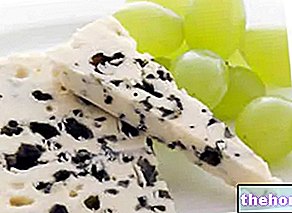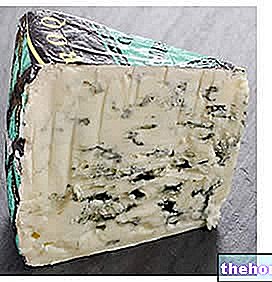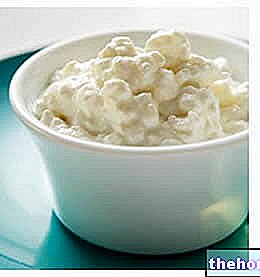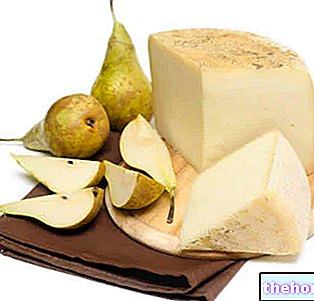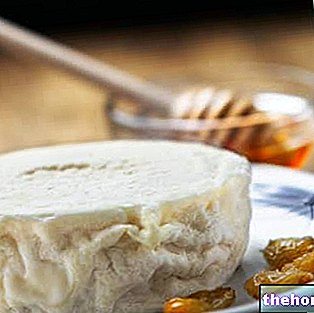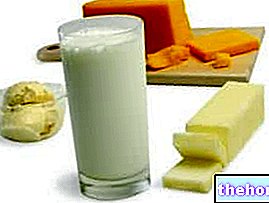Generality
Brie is a dairy food with a flowery crust with light molds; of French origins, it is produced in correspondence with the homonymous valley (department of Saine-et-Marne), located about 50km from the capital (to the east). It is a short-aged soft cheese made from cow's milk .

Brie differs in various very specific types, but (since 1980) only 2 bear the AOC (Appellation d "Origine Contolée - equivalent to our DOP) brand: Brie de Meraux and Brie de Melun. The first (the best known) boasts a delicate flavor, while the second has a decidedly stronger scent.
It is conceivable that Brie was born in the abbey of Notre-Dame de Jouarre, approximately in the 11th century AD.
As far as the nutritional aspect is concerned, Brie is considered a semi-fat cheese (up to 27% in lipids). It represents a rather caloric food, as it is rich above all in triglycerides and proteins. From the gustatory point of view, this cheese expresses itself " at most "in the summer and early autumn months.
Description and Production
Adapted from: Atlas of Cheeses: Guide to over 600 cheeses and dairy products from all over the world - G. Ottogalli - Publisher Urlico Hoepli Milan - pages 236: 238.
Brie is circular in shape (30-35cm in diameter), a few centimeters thick (2.5-4cm), felted by a thin film of white mold and with an approximate mass of 0.5-2kg for each shape. Like the other classic type floral rind cheeses (especially those from raw milk), Brie has a CENTRIPETAL ripening trend; this tendency to mature more rapidly in the center than on the outside gives it a particular STRATIGRAPHIC aspect, that is: a dark, creamy, yellowish under-rind and a more consistent central core, pure white color. The paste is greasy and has a typical taste.
Brie is a cheese made from raw cow's milk (today more often pasteurized). The seasoning lasts about 20-30 days (some mention 8 weeks) and takes place in humid places, once with straw supports to favor the development of the external white felt.
Recipes and Nutritional Characteristics
Brie is a cheese that does not keep for long; it should be kept in the refrigerator and only for a few days. From a gastronomic point of view, its culinary use (in recipes) is not recommended; consumption in fact includes a tasting in itself with a combination of fruity - light red wines (Touraine) but also full-bodied (Burgundy or Bordeax).
Sanitary and Hygienic Implications
The consumption of Brie is not recommended in case of pregnancy; this is attributable both to the superficial molding and to its predisposition to house other types of microorganisms.

Nutritional values (per 100 g of edible portion)
According to a study titled "Evaluation of the health and hygiene quality of some types of cheeses taken at the retail stage", published in the magazine"Veterinary Italian, 46, 221-231 ", it emerged that certain blue and moldy cheeses are more subject to bacterial contamination. Among these, Brie was found to be predisposed to host Listeria monocytogenes, a bacterium responsible for a type of food poisoning that is potentially harmful to the fetus.
In summary, taking into consideration that Brie does NOT lend itself to cooking, it is better to totally exclude it from the diet of the pregnant woman.
Nutritional Characteristics
Brie contains on average about 48-49% of water, 22-23% of fats (up to 27%), 20% of protein substances and 4% of ash (mineral salts).
Compared to what is mentioned in the table on the side, it can be seen that Brie is a food that is as useful as it is controversial. Like most cheeses, this also provides significant amounts of high biological value proteins, calcium, phosphorus, vit. A and vitamin B2 (Riboflavin); however, the high caloric - lipid density precludes its frequent use and in considerable portions, especially in the case of overweight.
Cholesterol is NOT negligible and it is reasonable to believe that the breakdown of fatty acids is in favor of saturated ones; this makes Brie a product not very suitable for the diet against hypercholesterolemia. The richness of calcium and phosphorus (essential for ossification) perfectly contextualizes it in the diet of the growing subject and of the elderly.
A last, but not least, note concerns the abundance of added sodium. Being a potentially unfavorable element for subjects affected by (or at risk) of hypertension, its intake with food should be moderated as much as effectively; obviously, the portion of Brie cheese is also reduced further.
Milk, Dairy Products and Cheeses Asiago Brie Burrata Caciocavallo Rennet Camembert Cheddar Milk Cream Crescenza Emmental Feta Milk Flakes Fontina Herbal Cheeses Lean Cheeses Cheeses rich in calcium Gorgonzola Gouda Grana Padano Gruyere Kéfalair Adapted milk Artificial milk Condensed milk Asphyxiated milk Goat's milk Sheep's milk Rice milk Soy milk Powdered milk and concentrated milk Skimmed and semi-skimmed milk Lactose-free milk Milk Vegetable milk Dairy products Lerdammer Mascarpone Montasio Buffalo mozzarella Mozzarella Whipped cream Cooking cream Fresh cream Parmigiano Reggiano Pecorino Philadelphia Primo Sale Provolone Ricotta Robiola Roquefort Scamorza Sottilette Squacquerone Taleggio Tomino Yogurt OTHER ARTICLES MILK AND DERIVATIVES Categories Alcoholic foods Meat Cereals and derivatives Sweeteners Sweets Offal Fruit Dried fruit Milk and derivatives Legumes Oils and fats Fish and fishery products Cold cuts S pezie Vegetables Health recipes Appetizers Bread, Pizza and Brioche First courses Second courses Vegetables and Salads Sweets and Desserts Ice creams and sorbets Syrups, liqueurs and grappa Basic preparations ---- In the kitchen with leftovers Carnival recipes Christmas recipes Light diet recipes Women's Day, Mum, Dad Recipes Functional Recipes International Recipes Easter Recipes Recipes for Celiacs Recipes for Diabetics Recipes for Holidays Recipes for Valentine's Day Recipes for Vegetarians Protein Recipes Regional Recipes Vegan Recipes

